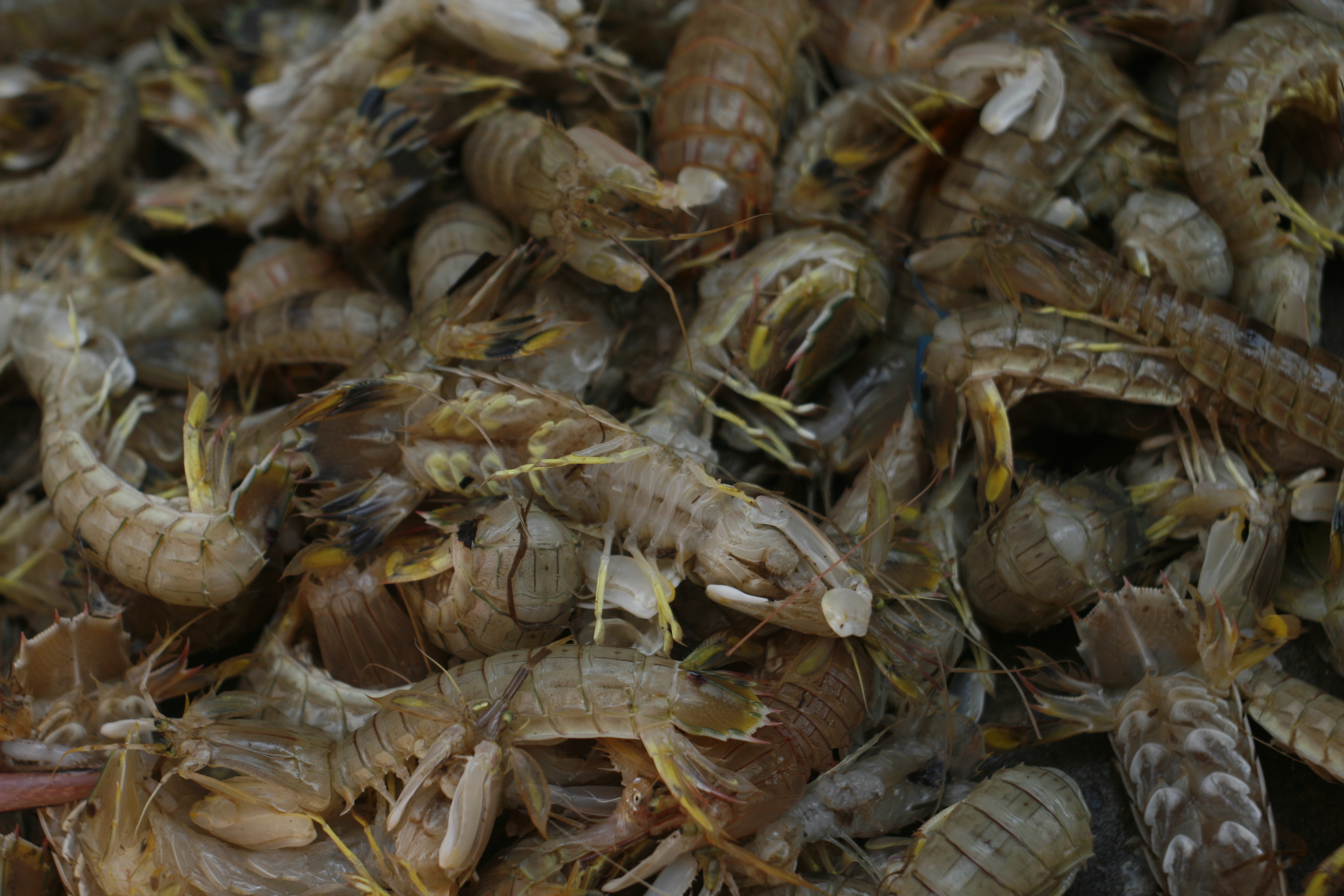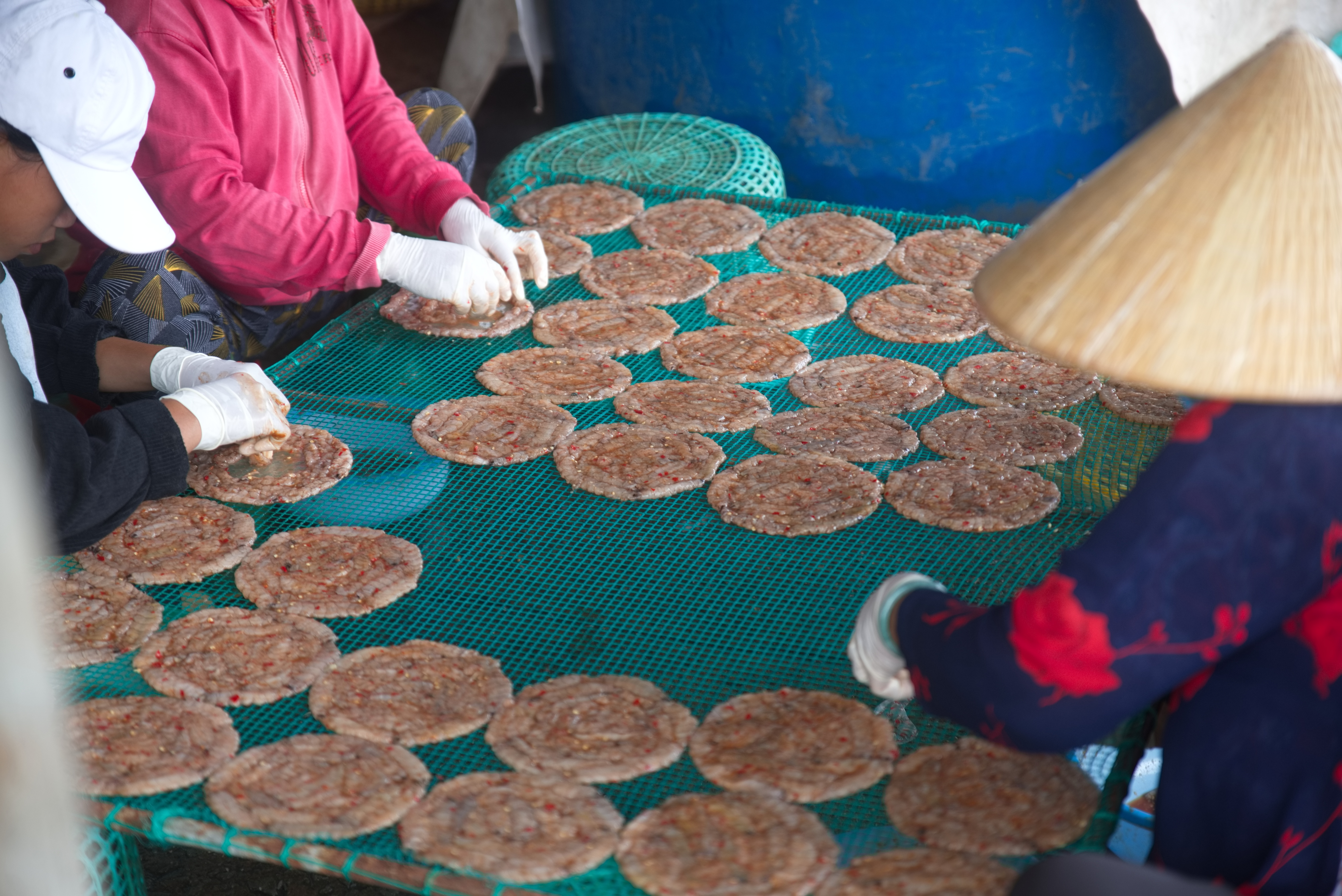구각목
"오늘의AI위키"의 AI를 통해 더욱 풍부하고 폭넓은 지식 경험을 누리세요.
1. 개요
구각목(Stomatopoda)은 고대 그리스어에서 유래된 이름으로, 입과 다리의 조합을 의미하며, 갑각류의 연갑강에 속하지만 새우와는 다른 종류이다. 갯가재는 전 세계의 따뜻한 바다에 널리 분포하며, 창 모양 또는 곤봉 모양의 강력한 포획지를 사용하여 먹이를 사냥한다. 갯가재는 복잡한 시각 시스템과 다양한 사회적 행동을 보이며, 일부 종은 형광 패턴을 사용하기도 한다. 갯가재는 식용으로 이용되기도 하며, 생체 모방 기술 및 관상용으로도 가치가 있다. 구각목은 고구각아목, 옛구각아목, 단순아목의 3아목으로 나뉘며, 단순아목에 현생 갯가재가 속한다.
더 읽어볼만한 페이지
- 구각목 - 갯가재
갯가재는 새우와 유사하게 생겼지만 극새우아강에 속하는 갑각류로, 강력한 집게발을 이용해 사냥하며 열대 및 아열대 얕은 바다에 서식하고, 정교한 시각 시스템과 독특한 사냥 전략을 지녔으며 일부 지역에서는 식용으로도 이용된다. - 살아있는 화석 - 투아타라
투아타라는 뉴질랜드 고유종 파충류이자 린코케팔리아목의 유일한 현존종으로, 오랜 진화 역사를 지니고 완전한 아래 측두궁 두개골, 첨생치, 두정안 등의 특징을 가지며 멸종 위기에 처해 뉴질랜드 정부의 보호를 받는다. - 살아있는 화석 - 코알라
코알라는 오스트레일리아에 서식하며 유칼립투스 잎을 주식으로 하는 유대류로, 멸종 위기에 처해 있으며, 물을 마시지 않는다는 의미의 이름과는 달리 실제로 물을 마시기도 하고, 호주를 대표하는 동물 중 하나로서 국제적인 인지도를 가지고 있다.
| 구각목 - [생물]에 관한 문서 | |
|---|---|
| 기본 정보 | |
 | |
 | |
| 학명 | Stomatopoda |
| 명명자 | 라트레이유, 1817 |
| 어원 | 그리스어 'στόμα(stóma, 입)' + 'ποδός(podós, 발)' |
| 분류 | |
| 아목 | † 고구각아목 (Palaeostomatopoda) † 옛구각아목 (Archaeostomatopoda) 단갑아목 (Unipeltata) |
| 상과 및 과 | 두꺼비구각상과 (Bathysquilloidea) 두꺼비구각과 (Bathysquillidae) 인도구각과 (Indosquillidae) 곤봉구각상과 (Gonodactyloidea) 알랭구각과 (Alainosquillidae) 반구각과 (Hemisquillidae) 곤봉구각과 (Gonodactylidae) 날개구각과 (Odontodactylidae) 프로토구각과 (Protosquillidae) 의태구각과 (Pseudosquillidae) 타쿠구각과 (Takuidae) 에리트로구각상과 (Erythrosquilloidea) 에리트로구각과 (Erythrosquillidae) 갯가재상과 (Lysiosquilloidea) 코로나구각과 (Coronididae) 갯가재과 (Lysiosquillidae) 난쟁이구각과 (Nannosquillidae) 테트라구각과 (Tetrasquillidae) 젓가락구각상과 (Squilloidea) 젓가락구각과 (Squillidae) 에우리구각상과 (Eurysquilloidea) 에우리구각과 (Eurysquillidae) 파라구각상과 (Parasquilloidea) 파라구각과 (Parasquillidae) |
| 생물학적 특징 | |
| 크기 | 최대 38 |
| 서식지 | 해양 |
| 먹이 | 갑각류, 연체동물, 어류 |
| 특징 | 강력한 펀치력 또는 찌르기 공격을 하는 낫 모양의 부속지 복잡한 시각 시스템 다양한 색상과 패턴 |
| 분포 및 서식 | |
| 서식지 | 열대 및 아열대 해양 |
| 분포 | 전 세계 |
| 기타 | |
| 학명의 어원 | 그리스어 'στόμα(stóma, 입)'과 'ποδός(podós, 발)'의 합성어 |
| 최초 출현 시기 | 고생대데본기 |
2. 명칭
갯가재의 학명은 ''Stomatopoda''이며, 고대 그리스어 "στόμα"(stóma, 입)와 "πούς"(pous, 다리)를 합쳐 만든 것이다.[68]
갯가재는 십각목 새우와 비슷하게 생겨서, 한국어, 영어, 중국어 모두 이름에 '새우'가 들어가는 경우가 많다. (prawn/shrimp[69], 蝦/虾)
- 일본어에서는 "'''샤코'''"(한자로 蝦蛄, 青竜蝦[70]) 또는 "'''샤코류'''", "'''구각류'''"라고 부른다. "샤코"는 일본에서 흔히 먹는 종인 ''Oratosquilla oratoria''의 표준명이기도 하다.[71]
- 영어에서는 학명에서 나온 "stomatopod"와, 사마귀(mantis) 앞다리처럼 생긴 포각 때문에 붙은 "'''mantis shrimp'''"(직역하면 "사마귀새우")가 많이 쓰인다.[85]
- 중국어에서는 "'''蝦蛄'''"(간체자로는 虾蛄, 병음으로는 Xiāgū, 샤구)[75][76]라고 하며, "'''蟷螂蝦'''"(영어 이름 "mantis shrimp"를 직역한 것), "'''富貴蝦'''", "'''皮皮蝦'''", "'''蝦耙子'''" 등 여러 별명도 있다.[77]
3. 형태
갯가재의 몸은 머리, 가슴, 배로 나뉘며, 다른 갑각류와 마찬가지로 홑눈, 눈, 입술에서 유래된 앞마디와 5쌍의 머리 부속지를 갖는다.[62] 머리는 다소 작고, 눈과 촉각을 가진 앞부분과 턱과 등갑을 가진 뒷부분으로 나뉜다.[62]
1쌍의 겹눈은 능동적인 안병에 돌출되어, 타원형 혹은 구형으로 발달했다. 일반적으로 각 겹눈의 표면은 중앙의 띠 모양 부분 (mid-band)과 그 양쪽의 반원형 부분 (hemispheres)이라는 3영역으로 상하로 나뉘며, mid-band는 더 크고 특화된 홑눈이 6열로 늘어서 있다.[90] 하지만 mid band의 홑눈 열이 2-3열 뿐이거나, mid band를 전혀 갖지 않는 예도 있다.[91][92][93]
제1 촉각의 자루는 긴 3마디이며, 선단의 채찍 모양 부분은 다른 현생 연갑류 (2개)와 달리 '''3개'''이다.[97][95][62] 제2 촉각은 이지형이며, 외지는 '''촉각 비늘'''이며, 특징적인 주걱 모양으로 발달하여 좌우로 매달려 있고, 가장자리에 강모가 늘어서 있다.[62]
배면을 덮고 있는 등갑의 선단 중앙에서 돌출된 짧은 이마뿔은 뚜껑처럼 관절된 가동의 이마판으로, 눈과 촉각의 체절을 덮고 있다.[62]
4. 생태
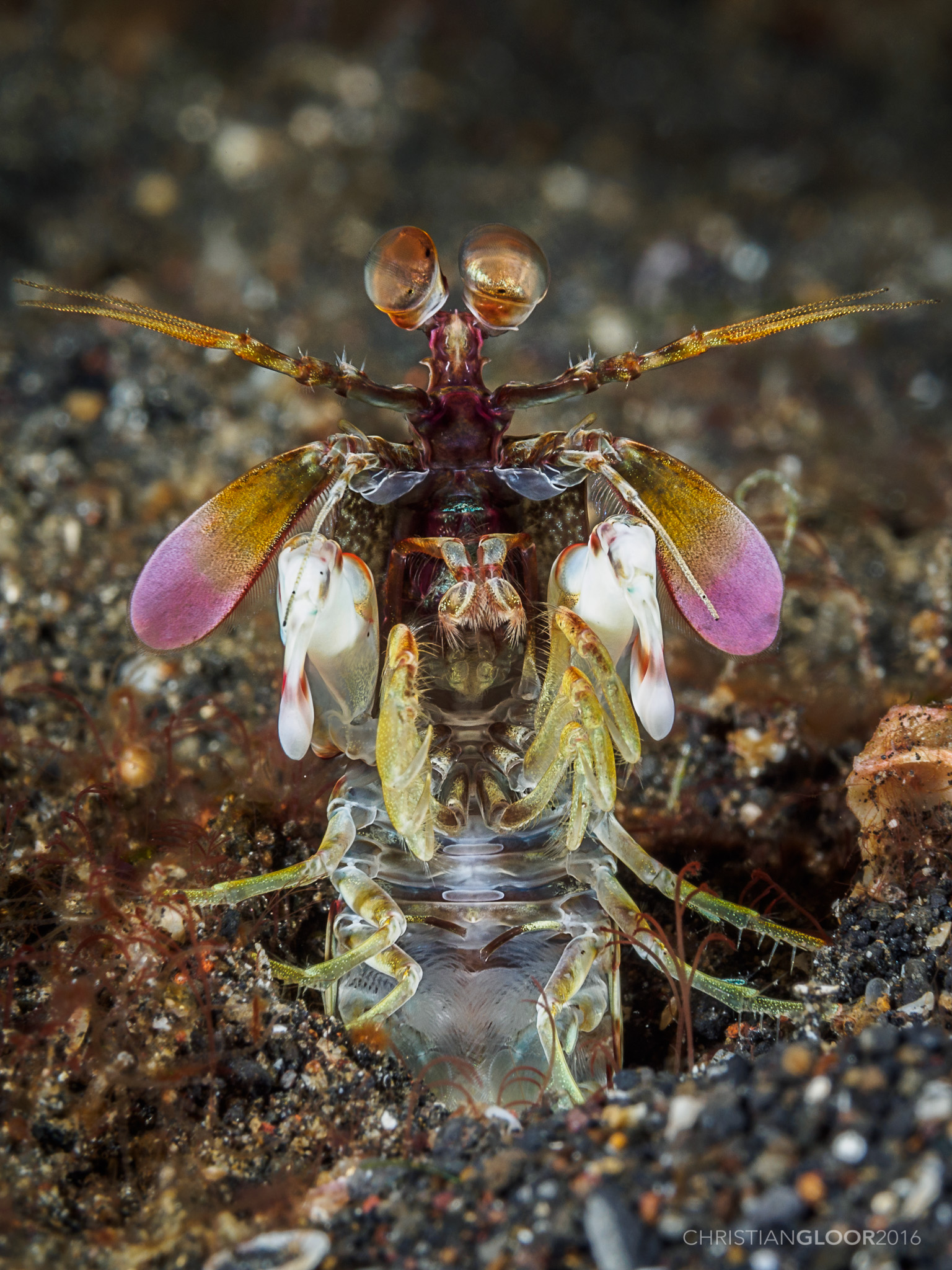
갯가재는 전 세계의 따뜻한 바다에 널리 분포하며, 대부분 해저에 굴을 파고 생활한다. 종에 따라 주행성, 야행성, 황혼형 동물 등 다양한 활동 양상을 보인다.
굴은 갯가재에게 휴식, 포식, 탈피, 교미, 알을 품는 장소로 이용된다. 창 종류는 부드러운 퇴적물에 굴을 만들고, 곤봉 종류는 단단한 기질이나 산호 동굴에 굴을 만든다. 갯가재는 굴을 만드는 습성 때문에 갯벌 생태계에서 중요한 역할을 하며, 다양한 생물들에게 서식처를 제공한다. 갯가재의 몸 크기는 주기적으로 성장하며, 동물의 새로운 직경에 맞는 새로운 동굴이나 굴을 찾아야 한다. 일부 창 종류는 굴이 흙이나 진흙으로 만들어진 경우, 굴을 확장하여 미리 구축된 서식지를 수정할 수 있다.[8]
4. 1. 행동
갯가재는 뛰어난 학습 능력을 가지고 있으며, 개체 식별 능력도 있는 것으로 알려져 있다.[158][98] 이는 종에 따라 자위(自衛)와 번식에 중요한 역할을 한다. 예를 들어, 과거에 만났던 강력한 천적이나 싸움 상대를 계속 기억함으로써 위험을 피하기 쉬워지고, 일부일처제의 종에서는 배우자를 동종의 다른 개체와 구별할 수 있게 된다.[158][98] 또한, 적어도 일부 타격형 종은 조건반사를 훈련할 수 있으며[173][169], 자연 환경에서는 만날 수 없는 형태의 굴이나 먹이를 며칠 안에 탐색하여 적응하는 것도 알려져 있다.[158] 한편, 갯가재과 종은 알려진 바로는 개체 식별 능력이 없다.[98]무지개새우과와 맨티스새우속 종은 후각을 바탕으로 개체를 기억하여 식별하며, 특히 전자는 시각적 신호를 통해 식별하기도 한다.[158][98] 많은 종들이 경쟁자로부터 자신들의 공간을 방어하기 위해 복잡한 사회적 행동을 발전시켰다.
갯가재는 "meral spread"라는, 촉각과 포획지를 펼치는 디스플레이를 하는 경우가 있다. 이 자세는 종류나 상황에 따라 다른 역할을 하며, 주로 대포식자위협·대 동종 위협·구애 행동이라는 세 가지 기능이 있다.[98] 대 포식자 위협의 meral spread는 갯가재류 전반에 공통적으로 가장 화려하며, 머리를 크게 뒤로 젖히고, 포획지 제4-6마디를 최대한 펼친다.[98] 한편, 대 동종 위협의 meral spread는 움직임이 절제되어 있으며, 포획지를 상대에게 향하고 머리를 뒤로 젖히지 않는다.[98] 또한, 포획지의 안장에 눈 모양 무늬를 가진 종류[181]의 경우, meral spread는 평소 머리에 숨겨진 눈 모양 무늬를 앞으로 드러낸다.[85][98][182][183][184]
Meral spread는 타격형이 가장 다기능적으로, 대 포식자 위협·대 동종 위협·구애 행동 모두에 사용된다. 그 중 눈 모양 무늬를 가진 과[185]와 갯가재과가 가장 화려하며, 체색이 선명한 종류일수록 공격적인 경향이 있다.[98] 한편, 자극형에서는 주로 대 포식자 위협에만 사용되며, 띠갯가재과만이 대 동종 위협에도 사용된다.[86][98]
타격형 갯가재는 동종 내에서 암컷 수컷에 관계없이 굴의 약탈과 수호를 위해 투쟁을 벌이는 것으로 알려져 있다.[98][186] 이 투쟁 행동은 "telson sparring"이라고 하며, 침입자는 포각의 타격으로 굴의 거주자를 공격하고, 몸을 둥글게 말아 내충격성의 미절을 앞으로 하여 방패처럼 거주자의 타격을 받아 공방전을 반복한다.[98][151][144][145][186] 투쟁 전에 거주자는 종종 포각을 펼쳐 위협(meral spread, 전술 참조)을 하고[151], 안장에 눈무늬를 가진 경우에는 그것을 앞으로 하여 눈에 띄게 한다.[187] 거주자는 이 위협으로 자신의 실력을 보이고, 침입자 또한 그것을 짐작할 수 있다고 생각된다. 예를 들어 눈무늬가 짙은 개체일수록 강한 타격을 가하며, 거주자의 눈무늬를 인위적으로 하얗게 칠하면, 침입자는 평소보다 경계를 풀고 공격적으로 된다.[182][183] 또한, 무방비 상태로 타격도 할 수 없는 탈피 직후의 거주자는 만약 침입자를 만나면, 투쟁할 수 없는 대신 허세로서의 위협을 한다. 만약 침입자가 반대로 이 허세에 공격적으로 되면, 거주자는 몸을 지키기 위해 굴을 포기하고 도망가지만, 소형 침입자에게는 효과가 있어, 종종 허세에 속아 물러난다.[187]
이 투쟁은 타격형에서 많이 보이는 한편, 자극형에서는 보이지 않으며[145], 이는 각각의 서식 환경과 크게 관련이 있다고 생각된다. 자극형의 굴은 퇴적물(모래나 진흙 등)이라는 풍부한 자원을 이용하는 데 반해, 많은 타격형이 서식하는 암석이나 산호초 등의 단단한 소재는 굴이 될 수 있는 장소(틈새)가 제한되어 있다. 그 결과, 굴의 점령은 타격형 사이에서 더욱 중요해지고, 자극형 이상으로 공격적으로 특화된 것으로 생각된다.[98]
갯가재는 평생 동안 20~30번의 번식 에피소드를 가질 수 있다. 종에 따라 알은 굴에 낳아 보관하거나, 부화할 때까지 암컷의 꼬리 아래로 옮겨질 수 있다. 또한 종에 따라 수컷과 암컷은 짝짓기를 위해서만 함께 하거나, 일부일처제의 장기적인 관계를 맺을 수 있다.[50]
일부일처제 종의 경우, 갯가재는 최대 20년 동안 동일한 짝과 함께 산다. 그들은 같은 굴을 공유하며 활동을 조율할 수 있다. 암수 모두 종종 알을 돌본다(양친 돌봄). ''풀로스킬라''(Pullosquilla)와 ''난노스킬라''(Nannosquilla)의 일부 종에서 암컷은 두 개의 알 덩어리를 낳는데, 하나는 수컷이 돌보고 다른 하나는 암컷이 돌본다. 다른 종에서는 암컷이 알을 돌보는 동안 수컷은 둘 다를 위해 사냥을 한다. 알이 부화한 후, 새끼는 최대 3개월 동안 플랑크톤으로 보낼 수 있다.
4. 2. 시각 시스템
갯가재의 눈은 동물계에서 가장 복잡한 시각 시스템 중 하나로 여겨진다. 인간의 눈이 3가지 유형의 광수용체를 가진 것에 비해, 갯가재의 눈은 12~16가지 유형의 광수용체를 가지고 있다.[19][20][21] 갯가재는 자외선,[30] 가시광선, 적외선, 편광[36][37][38]까지 감지할 수 있다.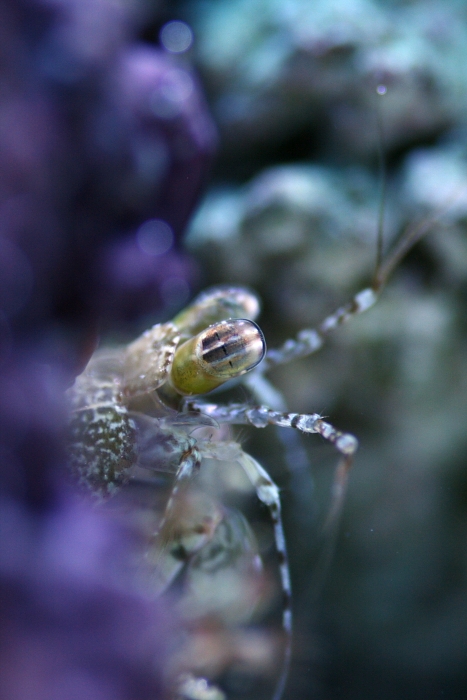
갯가재의 눈은 움직이는 눈자루에 달려 있으며 서로 독립적으로 움직일 수 있다. 이들은 동물계에서 가장 복잡한 눈을 가지고 있으며, 지금까지 발견된 시각 시스템 중 가장 복잡한 전면부를 가지고 있는 것으로 여겨진다.[19][20][21] 갯가재의 눈은 한쪽 눈만으로도 삼안시(trinocular vision) 입체시를 할 수 있어, 물체의 거리 등 삼차원 정보를 읽을 수 있다.[90]
갯가재의 시각 시스템은 색상 정보를 빠르게 식별하는 데 특화되어 있으며, 이는 포식 및 투쟁 행동에 유리하게 작용한다.[47] 갯가재는 여러 광수용체로부터 받은 신호를 중추 신경계(뇌)가 처리하여 혼합색을 만드는 것이 아니라, 각종 광수용체가 각각 특정 색을 직접적으로 감지한다.[173] 이 메커니즘은 색각이 떨어지는 대신, 뇌에 부하가 걸리는 비교 작업을 필요로 하지 않아, 광학적 신호를 빠르게 식별해야 하는 갯가재류의 다양한 생태 행동에 적합하다고 생각된다.[173]
1쌍의 겹눈(compound eye)은 능동적인 안병에 돌출되어, 타원형 혹은 구형으로 발달했다. 일반적으로 각 겹눈의 표면은 중앙의 띠 모양 부분 (mid-band)과 그 양쪽의 반원형 부분 (hemispheres)이라는 3영역으로 상하로 나뉘며, mid-band는 더 크고 특화된 홑눈이 6열로 늘어서 있다.[90]
4. 3. 포획지
갯가재의 두 번째 흉부 부속지(두 번째 턱다리)는 강력한 근거리 전투를 위해 고도로 발달되어 있으며, 포획지라고 불린다.[81][105][105] 갯가재의 영(영어)명 "mantis shrimp"에서 알 수 있듯이, 사마귀의 낫(앞다리)을 뒤집어 놓은 것과 같은 형태를 하고 있다.[98]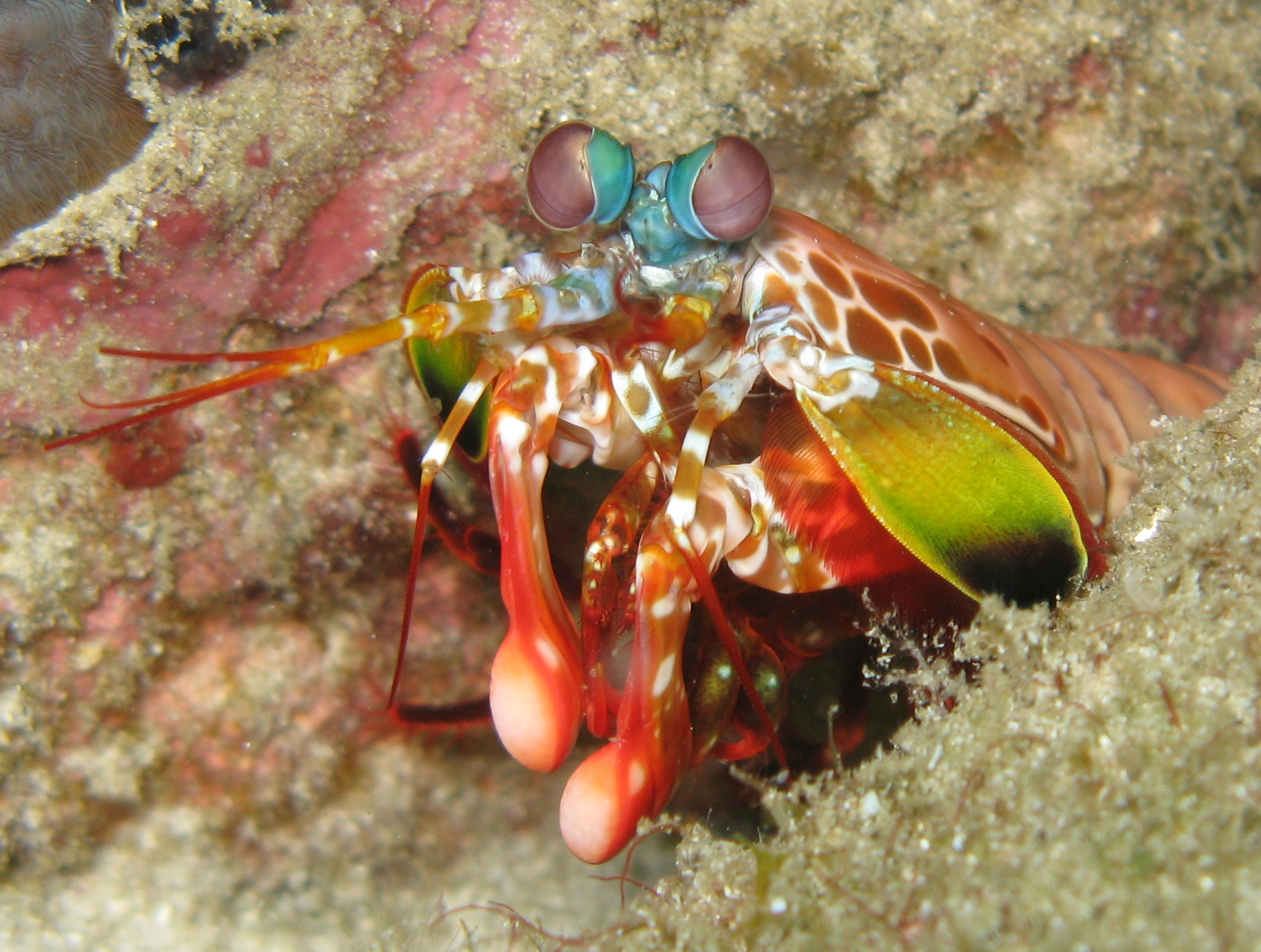
대부분의 현생 갯가재류는 포획지의 특화된 포식 방식에 따라 크게 자극형(spearer)[127]과 타격형(smasher)[128]으로 나뉜다. 자극형은 날카로운 가시가 발달한 창 모양의 포획지로 먹이를 찌르는 데 사용된다.[99][120][122] 타격형은 곤봉처럼 부풀어 오른 형태의 포획지로 먹이의 껍질을 부수는 데 사용된다.[85][99][113][129][130][120][131][132][133][134]
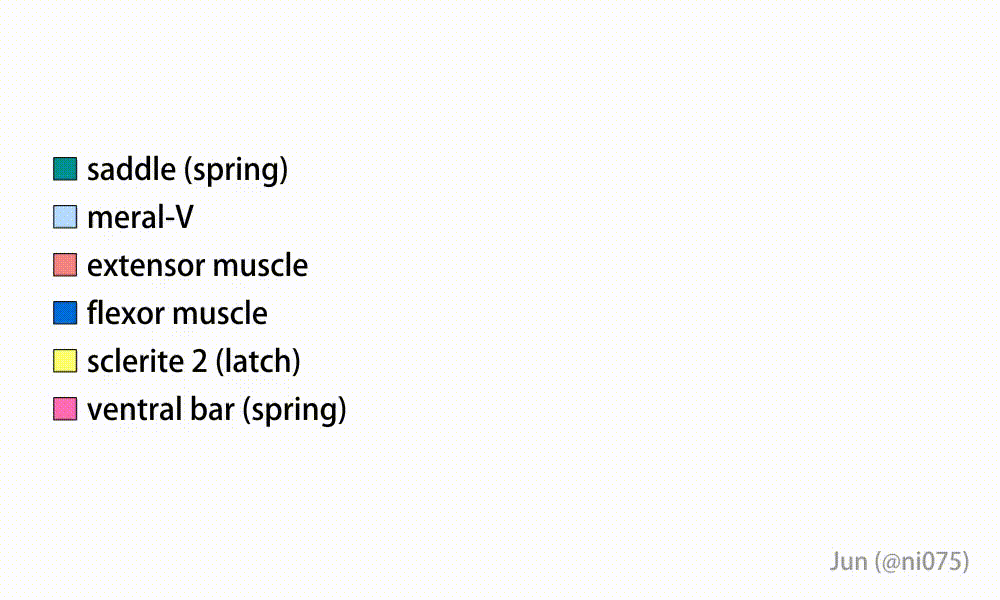
갯가재는 포획지를 매우 빠른 속도로 발사하여 먹이를 공격하며, 자신보다 훨씬 큰 먹이에게도 상당한 피해를 입힐 수 있다. 부수기(타격형)의 경우, 포획지는 102000m/s2 (335000ft/s2)의 가속도와 23m/s의 속도로 발사된다.[15] 이렇게 빠른 공격은 공동 현상 버블을 생성하고, 이 버블이 붕괴하면서 발생하는 충격파는 먹이에게 추가적인 피해를 입힌다.[15] 즉, 먹이는 발톱과 충격파에 의해 두 번 공격받는 셈이다.[16]
5. 번식과 발육
갯가재는 자웅이체이며, 번식기는 월주기와 일치하는 경우가 많다.[197] 교미 전에는 수컷과 암컷 모두 또는 한쪽이 구애 행동을 보이는데, 이는 종류에 따라 다르다. 촉각으로 서로를 만지거나,[198][199][200] 수컷이 제1 턱다리로 암컷을 쓰다듬거나,[199][200] 서로의 몸을 옆으로 붙이거나,[187][200] 포각을 펼쳐서 디스플레이 (meral spread, 전술 참조)를 하는[198][199] 행동 등이 알려져 있다. 대부분 수컷이 암컷에게 구애하고 암컷이 이를 받아들이거나 거부하지만, 일부 종류 (예: Pseudosquilla ciliatala)는 반대로 암컷이 구애하고 수컷이 선택한다.[199]
교미 시 암수컷은 X자 모양으로 서로의 몸을 생식기 부위 (수컷의 제8 흉절, 암컷의 제6 흉절)에서 교차시킨다.[198][199][200] 수컷은 음경을 암컷의 생식공에 삽입하고, 중앙의 주머니 모양 기관에 정자와 암컷 생식공을 막는 물질을 주입하여 산란 때까지 정자는 여기에 저장된다.[150] 짝짓기 관계는 일부일처제이거나, 암수 어느 한쪽이 여러 개체와 교미를 하는 경우가 있다.[198][158][98][197] 산란 시, 알은 체내 수정을 거쳐 체외에서 시멘트선에서 분비된 점액에 난괴로 묶인다.[150] 암컷은 난괴를 턱다리로 품고, 부화할 때까지 먹이도 먹지 않고 보호하며, 정기적으로 움직여 신선한 바닷물을 공급하고 부착 생물이 붙지 않도록 한다.[198][150]
갑각류는 일반적인 노플리우스 유생기가 없고, 성체와 같은 체절 수로 태어난다.[201] 부화에서 성체까지의 령기 (단계)는, 서식 양식에 따라 대략 전유영기 (propelagic stage)·유영기 (pelagic stage)·새끼 갯가재 (juvenile, postlarvae)의 3단계로 정리된다.[98] 새끼 갯가재는 성체와 비슷하지만, 전유영기와 유영기는 독특한 모습으로, 가늘고 긴 몸에 비해 등갑은 크고, 이마뿔과 양쪽 뒤쪽은 긴 가시로 발달했다.[98][201][83] 전유영기는 음 주광성으로 종종 난황을 가지며, 기능적인 걷는 다리와 아가미는 없고, 유영기까지 어미의 굴 안벽에 부착한다.[98] 어미의 굴에서 나와 플랑크톤으로 생활하는 유영기는, 적어도 걷는 다리 이외의 부속지는 기능적인 형태로, 령기를 거듭할수록 턱다리의 부지가 작아지고, 유영지의 아가미가 발달한다.[83] 유영기의 최종기는 원칙적으로 다음 탈피에서 새끼 갯가재로 변태하고, 착저하여 성체와 같은 저서 생활을 한다.
전유영기와 유영기는 각각 "'antizoea'"와 "'pseudozoea'", 그리고 "'erichthus'"와 "'alima'"의 4가지 유형이 알려져 있으며, 종류에 따라 "antizoea → erichtus" (사마귀새우상과)·"pseudozoea → erichtus" (애기갯가재상과, 넙적갯가재상과, Eurysquilloideala)·"pseudozoea → alima" (갯가재상과)의 어느 조합을 거쳐 성장한다.[98][100][201][204][83]
| 유형 | 분류군 | 겹눈 | 제1 촉각 편상부 | 턱다리 | 걷는 다리 | 유영지 | 미지 |
|---|---|---|---|---|---|---|---|
| antizoea | 사마귀새우상과 (?대형갯가재상과) | 안병 없음, 등갑에 밀착 | 1 | 제2-5 턱다리 거의 동일, 외지 있음 | 미발달 | 후기일수록 발달, 아가미 미발달 | 미발달 |
| pseudozoea | 갯가재상과 애기갯가재상과 넙적갯가재상과 Eurysquilloideala | 안병 있음, 등갑에서 돌출 | 2 | 제3-5 턱다리 미발달 | 미발달 | 아가미 미발달 | 미발달 |
| erichthus | 사마귀새우상과 애기갯가재상과 넙적갯가재상과 Eurysquilloideala | 안병 있음, 등갑에 덮임 | 3 | 제3-5 턱다리 후기일수록 발달 | 후기일수록 발달 | 아가미 후기일수록 발달 | 후기일수록 발달 |
| alima | 갯가재상과 | 안병 있음, 등갑에서 돌출 | 3 | 제3-5 턱다리 후기일수록 발달 | 후기일수록 발달 | 아가미 후기일수록 발달 | 후기일수록 발달 |
6. 인간과의 관계
매미새우는 다양한 문화권에서 식용으로 사용된다. 하와이에서는 일부 매미새우가 와이키키의 알라 와이 운하 오염된 물에서 비정상적으로 크게 성장했으며, 오염된 해산물 섭취 시 일반적으로 발생하는 위험이 존재한다.[3]
6. 1. 식용
일본 요리에서는 갯가재(''Oratosquilla oratoria'')를 ''shako''|蝦蛄일본어(샤코)라고 부르며, 삶아서 스시 토핑으로 먹거나 사시미로 먹기도 한다.[52]베트남에서는 갯가재를 ''bề bề'', ''tôm tích'', ''tôm tít'' 등으로 부르며, 냐짱 등지에서는 수세미 솔과 비슷하다고 하여 ''bàn chải''라고도 한다. 갯가재는 찜, 삶기, 굽기, 건조 등 다양하게 조리되며, 후추, 소금, 라임, 어간장, 타마린드, 회향 등과 함께 사용된다.[52]
광둥 요리에서는 물을 쏘는 습성 때문에 갯가재를 "오줌 새우"라고 부른다. 갯가재는 바닷가재와 비슷한 맛이 나며, 껍질이 매우 단단하다. 주로 튀긴 다음 마늘과 고추를 넣어 볶는 방식으로 조리한다.
지중해 연안, 특히 아드리아 해(canocchia)와 카디스 만(''galera'')에서는 갯가재 ''Squilla mantis''가 흔한 해산물이다.
필리핀에서는 갯가재를 ''tatampal, hipong-dapa,'' ''pitik-pitik'', ''alupihang-dagat'' 등으로 부르며, 다른 새우와 마찬가지로 조리한다.
키리바시에서는 갯가재를 길버트어로 ''te waro''라고 부르며, 삶아서 먹는다.
서태평양(동아시아, 동남아시아, 오스트레일리아 등)에서는 가시발갯가재속(가시발갯가재 등), 얼룩갯가재속(얼룩갯가재 등), 갯가재속 갯가재 등이 식재료로 어획된다.[98] 일본에서는 갯가재('''')가 잘 알려져 있다.[202] 지중해에서는 가,[221] 이집트 어시장에서는 가 일반적이다.[222] 다만, ''E. massavensis''는 홍해 원산의 외래종으로, 지중해에서 분포를 넓히며 토착종의 생태를 위협할 가능성이 제기된다.[222] 홍콩에서는 갯가재를 튀겨 마늘, 고추, 소금 등으로 간을 한 椒염뢰뇨하(椒鹽瀨尿蝦, 광둥어) 요리가 일반적이다.[223][224][225]
6. 2. 위험성
갯가재류는 포획지나 미지(꼬리다리)로 반격할 수 있기 때문에 함부로 만지면 부상을 입을 수 있다.[226] 특히 곤봉 종류의 갯가재는 강력한 타격으로 사람에게 상처를 입힐 수 있다.브라질 우바투바의 어부들은 찌르기형 갯가재의 날카로운 포획지에 찔리는 경우가 많으며, 둥근 상처가 남는다고 알려져 있다. 또한, 타격형 갯가재의 강력한 타격으로 인한 피해 사례도 보고되었다.[226]
따라서 갯가재를 다룰 때는 주의해야 하며, 안전 장비를 착용하는 것이 좋다.
6. 3. 생체 모방
갯가재류의 몇 가지 뛰어난 생리학적 특성은 생체 모방 기술 분야에서 주목받고 있다.[228][227][125] 갯가재의 포획 다리 파워 증폭 시스템을 해명하기 위해 그 기구를 모방한 로봇이 개발되었고,[227][176] ''Nannosquilla''영어 속의 체절 구조와 재주넘기 행동을 모방하여 같은 방법으로 빠르게 이동하는 소프트 로봇도 개발되고 있다.[228][229]공방용으로 강화된 갯가재 포획 다리의 지절종과 미절의 외골격은 튼튼하고 가벼워, 그 특수한 구조를 응용할 수 있다면 튼튼함과 가벼움을 효율적으로 겸비한 소재 개발로 이어질 수 있다.[230][125] 강력한 탄성에너지를 축적하는 스프링인 포획 다리의 안장은, 단독으로는 깨지기 쉬울 것 같은 세라믹을 포함하여 탄성 소재 개발에 새로운 영감을 주고 있다.[125]
6. 4. 관상
공작 갯가재를 비롯한 열대산 소형종은 체색이 화려하여 관상용으로 판매·사육된다.[75][231] 일본에서는 약 1,000종의 관상용 갑각류 중 갯가재류가 0.9%를 차지한다.[232]일부 해수 수족관 사육자들은 구각목을 사육한다.[53] 특히 공작 갯가재는 색상이 화려하여 인기가 많다.
어떤 수족관 사육자들은 갯가재를 높이 평가하지만, 다른 사람들은 해로운 해충으로 여기기도 한다. 갯가재는 탐욕스러운 포식자로서 수조의 다른 생물을 먹어치우기 때문이다. 게다가 일부 바위에 구멍을 파는 종들은 활착암에 피해를 입힐 수 있다.
갯가재 굴이 있는 활착암은 일부 해양 수족관 거래에서 유용하다고 여겨져 종종 수집된다. 활착암 조각은 살아있는 갯가재를 수족관으로 옮기기도 한다. 수조 안에 들어간 갯가재는 물고기 및 다른 생물을 잡아먹을 수 있으며, 자리를 잡으면 잡기가 매우 어렵다.[54] 갯가재가 유리 수조를 깨뜨린 사례도 있지만 드물며, 이는 대개 너무 작은 수조에 갯가재를 보관했기 때문이다. 구각목은 산호를 먹지 않지만, 파쇄자는 산호 안에 집을 지으려 할 경우 손상을 입힐 수 있다.[55]
7. 분류
갯가재목은 크게 고구각아목, 옛구각아목, 단순아목의 3아목으로 나뉜다. 현생 갯가재는 모두 단순아목에 속하며, 7상과 17과 100개가 넘는 속으로 분류된다.[93]
- 고구각아목 (데본기 - 석탄기)
- 등갑은 흉부 전체의 좌우를 덮는다.
- 제2-5 턱다리(제1-4 포각)는 형태가 같다.
- 미절(꼬리마디)은 타원형에서 삼각형이며, 원칙적으로 끝에 1개의 가시를 가진다.
- 옛구각아목 (석탄기)
- 등갑은 제5-8 흉절(가슴마디)을 덮지 않고, 양쪽 뒷부분이 제6 흉절까지 뻗어 있다.
- 제2-5 턱다리(제1-4 포각)의 분화 정도는 다양하다. (형태가 같은 것부터 제1 포각과 제4 포각의 크기 차이가 약 3배까지 나는 것까지)
- 미절(꼬리마디)은 세로 폭이 가로 폭보다 길고, 가장자리의 돌기는 적다.
- 단순아목 (중생대 쥐라기 - 현세)
- 이마뿔은 경첩 모양으로 관절한다.
- 눈과 촉각의 체절은 악두역과 분절(마디로 나뉨)된다.
- 제6-8 흉지는 보각(걷는 다리) 형태이다.
- 미지(꼬리다리) 원절(첫째 마디)에 발달한 가시가 있다.
- 미절(꼬리마디)이 크고 튼튼하다.
현생 갯가재는 모두 단순아목에 속하며, 다음과 같이 분류된다.
| 상과 | 과 |
|---|---|
| 오키주걱벌레붙이상과 (Bathysquilloidea) | |
| 가위갯가재상과 (Gonodactyloidea) | |
| 눈콩게상과 (Erythrosquilloidea) | |
| Eurysquilloidea | |
| 줄무늬참게상과 (Lysiosquilloidea) | |
| 넓적배사마귀새우상과 (Parasquilloidae) | |
| 갯가재상과 (Squilloidea) |
7. 1. 갯가재목 (Stomatopoda)
Stomatopoda영어는 고대 그리스어의 "στόμα"(stóma, 입)와 "πούς"(pous, 다리)의 합성어이다.[68]갯가재류는 독자적인 목(갯가재목/구각목)으로 분류되며, 갑각류 중에서 같은 연갑강에 포함되지만, 십각목의 새우는 아니다. 그러나 갯가재류는 겉보기에는 새우와 비슷한 모습으로, 한국어, 영어, 중국어 모두 호칭에 "새우"(prawn/shrimp[69], 蝦/虾)가 붙는 경우가 있다.
- 일본어에서는 총칭으로 "'''샤코'''"(한자 전사: 蝦蛄, 青竜蝦[70])・"'''샤코류'''"・"'''구각류'''"가 있으며, "샤코"는 일본에서 일반적으로 식용으로 사용되는 종 ''Oratosquilla oratoria''를 가리키는 표준명이기도 하다.[71]
- 영어에서는 학명에 연유한 "'''stomatopod'''"와, 사마귀(mantis)의 앞다리와 비슷한 낫 모양의 포각에서 유래한 "'''mantis shrimp'''"(직역: "사마귀새우")가 총칭으로 일반적이다.[85]
- 중국어에서는 "'''蝦蛄'''"(간체자: 虾蛄, 병음: Xiāgū, 샤구)[75][76] 외에, "'''蟷螂蝦'''"・"'''富貴蝦'''"・"'''皮皮蝦'''"・"'''蝦耙子'''" 등 수많은 별명이 알려져 있다.[77]
갯가재류는 동물계에서도 특화된 시각계를 가지고 있다. 발달한 겹눈은 한쪽 눈만으로도 삼안시(trinocular vision) 입체시를 할 수 있으며, 물체의 거리 등 삼차원 정보를 읽을 수 있다.[90] 갯가재류의 겹눈은 항상 불규칙하고 다양한 방향으로 회전한다.[158][90]
발달한 mid band(중앙의 띠 모양 영역)를 가진 종류의 겹눈은 10종 이상[160][161](종류에 따라 16~21종)의 광수용체를 가지고 있으며, 이는 알려진 동물의 눈 중에서 가장 많다.[163][90][173] 따라서 갯가재류의 겹눈은 종류에 따라 색의 차이(색각)뿐만 아니라, 자외선[162][163][164][165][166][167][168][169]과 편광(원편광[170])[96][171]까지 식별할 수 있다.[172][98]
현생 생물에 한정하면, 연갑강의 갑각류 중에서 갯가재목(구각목)은 잎새새우목(박갑목) 다음으로 일찍 분기되었으며, 그 외의 현생 연갑류의 목을 포함하는 계통군의 자매군으로 여겨진다.[80][98][205] 멸종된 생물까지 범위를 넓히면, 고생대석탄기에만 알려진 기유목[139]은 갯가재목의 자매군으로 여겨진다.[207][208][61][98][63]
형태상으로, 가시새우아강은 등갑과 연결된 미모, 6개의 복부 등의 성질을 겸비함과 동시에, 제1촉각의 3개의 채찍 모양 부분, 4절 이하의 흉지 내지, 복지 유래의 아가미를 함께 가지고 있어 다른 연갑류와 구별된다.[80] 그 중 갯가재목은 짧은 제2소악, 등갑에 융합되지 않는 제5-8 흉절, 낫 모양 (아협상)의 제2-5악각(집게다리)을 가지고 있어 기유목과 구별된다.[97][98]
2017년 시점에서는 대략 500종의 갯가재류가 기재되어 있다.[93] 갯가재목은 고생대데본기와 석탄기의 멸종된 종만 알려진 '''고구각아목'''과 '''옛구각아목''', 그리고 중생대쥐라기부터 현세까지 이어지는 '''단순아목'''의 3아목으로 나뉜다.[106][207][61][98]
갯가재목과 각 아목의 정의는 다음과 같다.
- '''''''''' '''갯가재목'''('''구각목''')
- †'''''''''' '''고구각아목'''
- †'''''''''' '''옛구각아목'''
- '''''''''' '''단순아목'''
7. 1. 1. 고구각아목 (Palaeostomatopoda)
데본기의 Eopteridae는 초기 구각목으로 제안되었지만, 단편적인 유해로 인해 분류가 불확실하다.[56]- '''고구각아목''' (데본기 - 석탄기) - 등갑은 흉부 전체의 좌우를 덮음. 제2-5 턱다리(제1-4 포각)는 동형. 미절은 타원형에서 삼각형이며, 원칙적으로 말단 1개의 가시를 가짐.
- ** (데본기)
- ** (석탄기)
- ** ? (데본기) (미지만 알려져 있으며, 한때 곤충의 날개로 오해되었다.[210][98][211])
7. 1. 2. 옛구각아목 (Archaeostomatopoda)
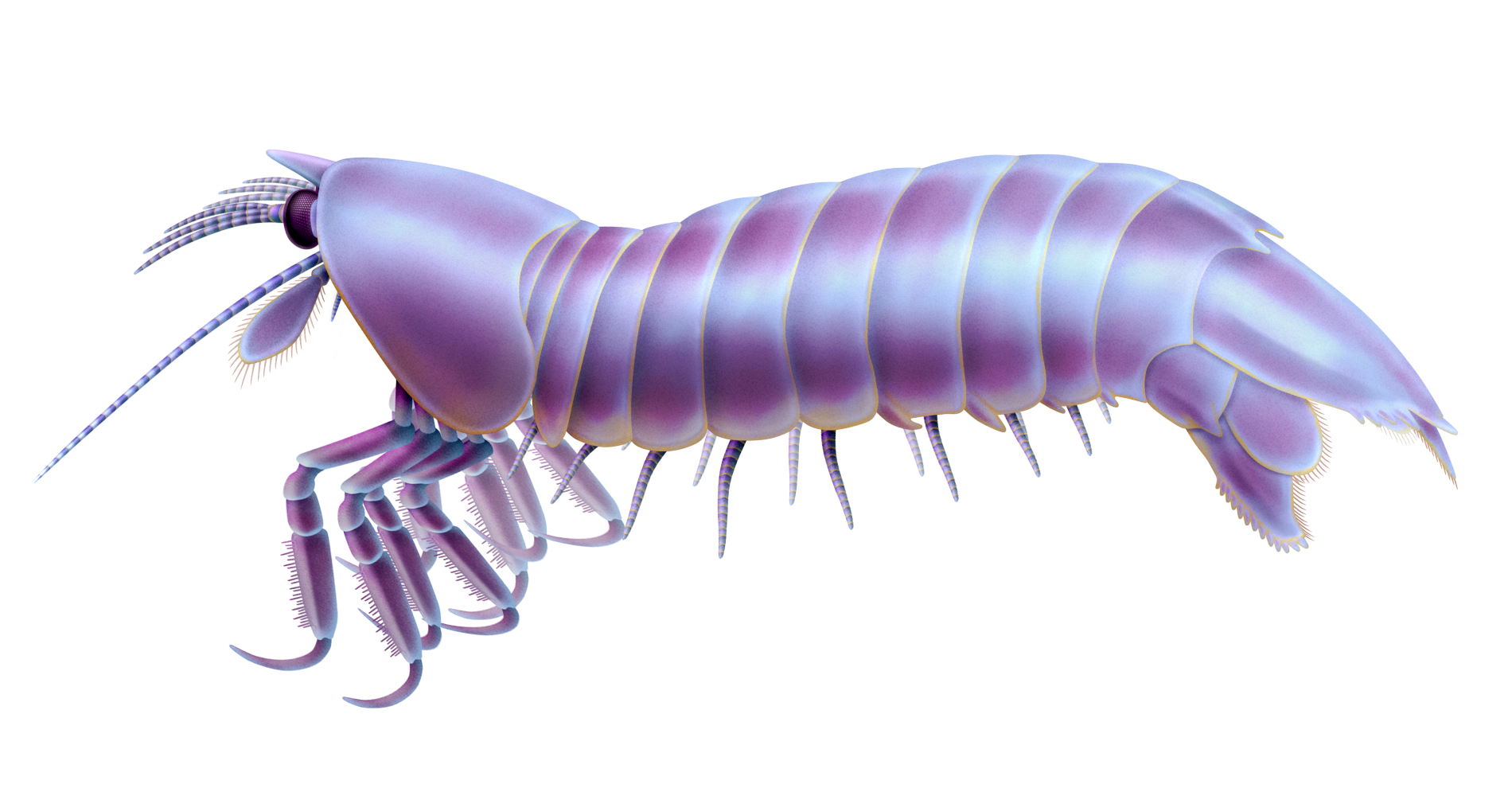
석탄기(3억 5900만 년에서 3억 년 전)의 줄기군 구각목에는 Palaeostomatopodea와 Archaeostomatopoda가 있으며, 이중 옛구각아목(Archaeostomatopoda)은 현대 구각목과 더 밀접한 관련이 있어 Unipeltata 분류군으로 분류된다.[56]
옛구각아목(Archaeostomatopoda)은 등갑이 제5-8 흉절을 덮지 않고, 양쪽 후연이 제6 흉절까지 뻗어 있다. 제2-5 턱다리(제1-4 포각)의 분화 정도는 다양하다(동형에서 제1과 제4 포각의 차이가 약 3배까지). 미절은 세로 폭이 가로 폭보다 길고, 가장자리의 돌기는 적다.
옛구각아목에는 다음 과와 속이 있다.
7. 1. 3. 단순아목 (Unipeltata)
전 세계적으로 약 520종의 갯가재(mantis shrimp)가 발견되었으며, 모든 현존하는 종은 약 2억 5천만 년 전에 나타난 자루새우아목(Unipeltata)에 속한다.[2][7]단순아목은 다음 상과들을 포함한다.
| 상과 | 과 |
|---|---|
| 오키주걱벌레붙이상과 (Bathysquilloidea) | |
| 가위갯가재상과 (Gonodactyloidea) | |
| 눈콩게상과 (Erythrosquilloidea) | |
| Eurysquilloidea | |
| 줄무늬참게상과 (Lysiosquilloidea) | |
| 넓적배사마귀새우상과 (Parasquilloidae) | |
| 갯가재상과 (Squilloidea) |
참조
[1]
서적
An Updated Classification of the Recent Crustacea
http://atiniui.nhm.o[...]
Natural History Museum of Los Angeles County
2009-12-14
[2]
논문
The evolutionary history of Stomatopoda (Crustacea: Malacostraca) inferred from molecular data
2017-09-21
[3]
뉴스
Large shrimp thriving in Ala Wai Canal muck
http://the.honolulua[...]
2003-02-15
[4]
서적
Extraordinary Animals: An Encyclopedia of Curious and Unusual Animals
https://archive.org/[...]
Greenwood Press
[5]
웹사이트
Mantis shrimp
http://www.qm.qld.go[...]
[6]
서적
Seashore Life of Florida and the Caribbean
https://archive.org/[...]
Courier Dover Publications
[7]
웹사이트
Stomatopoda
http://tolweb.org/St[...]
2002-01-01
[8]
서적
Chemical Communication in Crustaceans
Springer
[9]
웹사이트
How the Mantis Shrimp Packs its Punch | Biomechanics in the Wild
https://sites.nd.edu[...]
[10]
웹사이트
Why are Mantis Shrimp so Awesome?
https://www.calacade[...]
2022-07-21
[11]
웹사이트
How mantis shrimp evolved many shapes with same powerful punch
https://phys.org/new[...]
2022-07-21
[12]
웹사이트
Roy's List of Stomatopods for the Aquarium
https://ucmp.berkele[...]
2022-07-21
[13]
웹사이트
a_derijardi
https://ucmp.berkele[...]
2022-07-21
[14]
웹사이트
h_californiensis
https://ucmp.berkele[...]
2022-07-21
[15]
논문
Deadly strike mechanism of a mantis shrimp
https://pateklab.bio[...]
2017-05-02
[16]
논문
Extreme impact and cavitation forces of a biological hammer: strike forces of the peacock mantis shrimp
[17]
뉴스
Mantis shrimp inspires next generation of ultra-strong materials
https://www.spacedai[...]
2020-05-13
[18]
논문
Complex gaze stabilization in mantis shrimp
2018-05-16
[19]
논문
Filtering and polychromatic vision in mantis shrimps: themes in visible and ultraviolet vision
2014-02-19
[20]
웹사이트
Mantis shrimp have the world's best eyes – but why?
https://theconversat[...]
The Conversation
2018-07-05
[21]
논문
Mantis shrimp flub color vision test
[22]
논문
Sensory adaptation: Tunable colour vision in a mantis shrimp
[23]
논문
Evolutionary variation in the expression of phenotypically plastic color vision in Caribbean mantis shrimps, genus Neogonodactylus.
http://darchive.mblw[...]
2019-09-02
[24]
논문
Molecular diversity of visual pigments in Stomatopoda (Crustacea)
2009-05-01
[25]
논문
Colour vision in stomatopod crustaceans: more questions than answers
https://journals.bio[...]
2022-03-15
[26]
논문
The Evolution of Complexity in the Visual Systems of Stomatopods: Insights from Transcriptomics.
[27]
논문
Evolution of anatomical and physiological specialisation in the compound eyes of stomatopod crustaceans.
[28]
논문
A Different Form of Color Vision in Mantis Shrimp
2014-01-24
[29]
논문
Ultraviolet vision: the colourful world of the mantis shrimp
1999-10-28
[30]
논문
Biological Sunscreens Tune Polychromatic Ultraviolet Vision in Mantis Shrimp
[31]
뉴스
Mantis shrimp wear tinted shades to see UV light
http://www.latimes.c[...]
2014-11-22
[32]
논문
The use of different eye regions in the mantis shrimp ''Hemisquilla californiensis'' Stephenson, 1967 (Crustacea: Stomatopoda) for detecting objects
[33]
논문
The molecular genetics and evolution of colour and polarization vision in stomatopod crustaceans.
[34]
웹사이트
Mantis shrimp use 'nature's sunblock' to see UV
https://www.science.[...]
2014-07-05
[35]
논문
Parallel processing and image analysis in the eyes of mantis shrimps
https://www.biodiver[...]
2021-05-24
[36]
논문
Circular polarization vision in a stomatopod crustacean
2008-03-25
[37]
논문
The secret world of shrimps: polarisation vision at its best
[38]
논문
Circularly polarized light detection in stomatopod crustaceans: a comparison of photoreceptors and possible function in six species
2017-09-15
[39]
논문
A biological quarter-wave retarder with excellent achromaticity in the visible wavelength region
[40]
웹사이트
A crustacean eye that rivals the best optical equipment
https://arstechnica.[...]
Ars Technica
2017-06-14
[41]
웹사이트
"Weird beastie" shrimp have super-vision
http://news.national[...]
National Geographic Society
2008-05-19
[42]
논문
Complex gaze stabilization in mantis shrimp
2018-05-16
[43]
웹사이트
Mantis shrimp have perfected the eye roll to see things we can't imagine
http://www.newsweek.[...]
2017-02-06
[44]
논문
Out of the blue: the evolution of horizontally polarized signals in Haptosquilla (Crustacea, Stomatopoda, Protosquillidae)
2014-08-07
[45]
간행물
Mantis shrimps could show us the way to a better DVD
http://www.bristol.a[...]
University of Bristol
2020-05-13
[46]
논문
Fluorescent enhancement of signaling in a mantis shrimp
[47]
논문
Mantis shrimp's super colour vision debunked
2014-01-23
[48]
웹사이트
Parallels between Shrimp and Human Color Vision
https://blogs.scient[...]
2020-05-13
[49]
Webarchive
New type of optical material discovered in the secret language of the mantis shrimp
http://www.bristol.a[...]
Bristol University
2016-02-17
[50]
웹사이트
Sharing the job: monogamy and parental care
http://www.ucmp.berk[...]
University of California, Berkeley
2009-11-13
[51]
논문
A unique form of locomotion in a stomatopod – backward somersaulting
[52]
웹사이트
Tôm tít – Đặc sản miền sông nước
http://www.dinhduong[...]
Dinh dưỡng
2011-01-08
[53]
Webarchive
A Load of Learnin' About Mantis Shrimps
http://reefkeeping.c[...]
ReefKeeping
2014-02-19
[54]
서적
The Marine Aquarium
London: Andromeda
[55]
뉴스
Shrimp spring into shattering action
https://www.usatoday[...]
2017-09-04
[56]
논문
The evolutionary history of Stomatopoda (Crustacea: Malacostraca) inferred from molecular data
2017-09-21
[57]
논문
Closing a major gap in mantis shrimp evolution - first fossils of Stomatopoda from the Triassic
http://www.geology.c[...]
2023-05-23
[58]
논문
Raymond B. Manning: an appreciation
[59]
문서
[60]
문서
[61]
논문
Evolution of mantis shrimps (Stomatopoda, Malacostraca) in the light of new Mesozoic fossils
http://www.biomedcen[...]
[62]
논문
Tagmatization in Stomatopoda – reconsidering functional units of modern-day mantis shrimps (Verunipeltata, Hoplocarida) and implications for the interpretation of fossils
https://doi.org/10.1[...]
2012-11-14
[63]
Citation
The Fossil Record of the Pancrustacea
https://www.research[...]
Oxford University Press
2022-03-29
[64]
웹사이트
Gebiidea アナジャコ下目 - Biological Information System for Marine Life
https://www.godac.ja[...]
2022-03-29
[65]
웹사이트
Crangonoidea エビジャコ上科 - Biological Information System for Marine Life
https://www.godac.ja[...]
2022-03-29
[66]
웹사이트
Laomediidae ハサミシャコエビ科 - Biological Information System for Marine Life
https://www.godac.ja[...]
2022-03-29
[67]
웹사이트
Unipeltata - Biological Information System for Marine Life
https://www.godac.ja[...]
2022-03-29
[68]
Citation
stomatopod
https://en.wiktionar[...]
2022-01-30
[69]
문서
[70]
웹사이트
蝦蛄とは
https://kotobank.jp/[...]
2022-01-30
[71]
웹사이트
口脚類とは
https://kotobank.jp/[...]
2022-01-30
[72]
웹사이트
シャコ
https://www.hro.or.j[...]
2022-01-30
[73]
서적
Seashore Life of Florida and the Caribbean
https://books.google[...]
Courier Corporation
2002-01-01
[74]
웹사이트
Mantis Shrimps - Queensland Museum
https://www.qm.qld.g[...]
2022-01-30
[75]
서적
A catalog of the mantis shrimps (Stomatopoda) of Taiwan
https://scholars.nto[...]
National Taiwan Ocean University
2008-08
[76]
간행물
蝦蛄
https://en.wiktionar[...]
2022-01-10
[77]
서적
烹飪原料學
https://books.google[...]
崧博出版
2019-02-20
[78]
간행물
瀨尿蝦
https://en.wiktionar[...]
2021-11-02
[79]
논문
国内におけるヒメシャコ科2種 (軟甲綱: 口脚目) の追加産地記録
https://hdl.handle.n[...]
Ryukyu University Museum, Fujukan
2020-07-03
[80]
논문
Phylogenetic analysis of the Malacostraca (Crustacea)
https://www.research[...]
2001-09
[81]
논문
食卓で学ぶ甲殻類のからだのつくり : エビ・カニ・シャコ類の教材化に関する研究
https://doi.org/10.1[...]
広島大学大学院教育学研究科
2022-02-11
[82]
논문
Early Crustacean Evolution and the Appearance of Epipods/Gills
https://www.research[...]
2009-09-01
[83]
논문
Detailed description of some mantis shrimp larvae and their implication for the character evolution within Stomatopoda
http://www.scielo.br[...]
2020-02-14
[84]
간행물
Stomatopods
https://www.research[...]
2014-01-01
[85]
논문
Stomatopods
https://www.research[...]
1976-01
[86]
논문
Fluorescent Enhancement of Signaling in a Mantis Shrimp
https://www.research[...]
2004-02-01
[87]
간행물
Arthropod Segmentation and Tagmosis
https://link.springe[...]
Springer Berlin Heidelberg
2022-01-26
[88]
논문
甲殻類系統発生雑記(動物分類学会シンポジウム講演要旨)
https://doi.org/10.1[...]
1963
[89]
문서
Crustacea. A Treatise on Zoology, Part VII, Appendiculata, Third Fascicle
Adam and Charles Black, London
1909
[90]
논문
Stomatopod eye structure and function: A review
https://www.ecovis.o[...]
2007-12-01
[91]
문서
[[オキシャコ上科]]、Eurysquilloidea、[[ヒラメホソユビシャコ上科]]、[[シャコ上科]]
[92]
논문
Evolution of anatomical and physiological specialization in the compound eyes of stomatopod crustaceans
https://doi.org/10.1[...]
2010-10-15
[93]
논문
The evolutionary history of Stomatopoda (Crustacea: Malacostraca) inferred from molecular data
https://www.ncbi.nlm[...]
2017-09-21
[94]
논문
Cerebral photoreception in mantis shrimp
https://www.nature.c[...]
2018-06-26
[95]
논문
The peripheral and central antennular pathway of the Caribbean stomatopod crustacean ''Neogonodactylus oerstedii''
https://www.research[...]
2003-10
[96]
논문
Polarization signals in mantis shrimps
https://www.research[...]
2009-08-20
[97]
서적
Some Middle Pennsylvanian Hoplocarida (Crustacea) and their phylogenetic significance
https://archive.org/[...]
Chicago : Field Museum of Natural History
1969
[98]
서적
Treatise on Zoology - Anatomy, Taxonomy, Biology. The Crustacea, Volume 4 part A
https://books.google[...]
BRILL
2013-10-24
[99]
논문
The functional morphology of stomatopod Crustacea
https://royalsociety[...]
1981-05-12
[100]
논문
An Intermetamorphic Larval Stage of a Mantis Shrimp and Its Contribution to the 'Missing-Element Problem' of Stomatopod Raptorial Appendages
https://journalarrb.[...]
2016-05-14
[101]
논문
Calcium phosphate mineralization is widely applied in crustacean mandibles
https://www.research[...]
2016-04
[102]
논문
L'Origine Protocéphalique De La Carapace Chez Les Thermosbaenacés, Tanaidacés, Cumacés Et Stomatopodes
https://brill.com/vi[...]
1993
[103]
논문
XVIII.— On the classification of the Crustacea Malacostraca
https://www.tandfonl[...]
1904-02
[104]
문서
Invertebrates
Sinauer Associates, Sunderland, Massachusetts
2003
[105]
웹사이트
捕脚とは
https://kotobank.jp/[...]
2022-01-20
[106]
논문
PHYLOGENETIC ANALYSIS OF THE STOMATOPODA (MALACOSTRACA)
https://doi.org/10.1[...]
1997-01-01
[107]
논문
Structure and mineralization of the spearing mantis shrimp (Stomatopoda; ''Lysiosquillina maculata'') body and spike cuticles
https://www.scienced[...]
2021-12-01
[108]
논문
The mechanics and neural control of the prey capture strike in the mantid shrimps ''Squilla'' and ''Hemisquilla''
https://doi.org/10.1[...]
1969-12-01
[109]
논문
Neuromuscular physiology of the strike mechanism of the mantis shrimp, ''Hemisquilla''
https://onlinelibrar[...]
1972-01-01
[110]
논문
Comparative muscle physiology of the mantis shrimp's raptorial appendage
https://www.research[...]
2010-01-01
[111]
논문
Biomechanics of Hierarchical Elastic Systems
https://hdl.handle.n[...]
2015-01-01
[112]
논문
Feed-forward motor control of ultrafast, ballistic movements
https://doi.org/10.1[...]
2016-02-01
[113]
논문
Deadly strike mechanism of a mantis shrimp
http://www.nature.co[...]
2004-04-01
[114]
논문
Modularity and Scaling in Fast Movements: Power Amplification in Mantis Shrimp
https://onlinelibrar[...]
2011-01-01
[115]
논문
When Skeletons Are Geared for Speed: The Morphology, Biomechanics, and Energetics of Rapid Animal Motion
https://www.research[...]
2012-11-01
[116]
웹사이트
The Most Powerful Movements in Biology
https://www.american[...]
2017-02-06
[117]
논문
The Power of Mantis Shrimp Strikes: Interdisciplinary Impacts of an Extreme Cascade of Energy Release
https://doi.org/10.1[...]
2019-12-01
[118]
웹사이트
超高速運動 - JSCPB wiki
https://cns.neuroinf[...]
2017-02-18
[119]
논문
Linkage mechanics and power amplification of the mantis shrimp's strike
https://doi.org/10.1[...]
2007-10-15
[120]
논문
Comparative spring mechanics in mantis shrimp
https://www.research[...]
2012-01-01
[121]
논문
Gearing for speed slows the predatory strike of a mantis shrimp
https://www.research[...]
2012-04-01
[122]
논문
Strike mechanics of an ambush predator: the spearing mantis shrimp
https://www.research[...]
2012-12-15
[123]
논문
Shooting mechanisms in nature
https://www.research[...]
2016-01-01
[124]
논문
Mechanical sensitivity and the dynamics of evolutionary rate shifts in biomechanical systems
https://www.research[...]
2017-01-25
[125]
논문
Biomechanical Design of the Mantis Shrimp Saddle: A Biomineralized Spring Used for Rapid Raptorial Strikes
https://www.scienced[...]
2018-10-26
[126]
문서
フトユビシャコ科、ウニシャコ科、ハサミオシャコ科
[127]
문서
オキシャコ上科、オオメシャコ上科、ホソユビシャコ科、トラフシャコ上科、ヒラメホソユビシャコ上科、シャコ上科
[128]
문서
フトユビシャコ上科のうち、ハリツメシャコ科(中間型)とホソユビシャコ科(刺撃型)以外のもの。
[129]
논문
Extreme impact and cavitation forces of a biological hammer: strike forces of the peacock mantis shrimp ''Odontodactylus scyllarus''
https://doi.org/10.1[...]
2005-10-01
[130]
논문
The Stomatopod Dactyl Club: A Formidable Damage-Tolerant Biological Hammer
https://www.research[...]
2012-06-08
[131]
논문
Textured fluorapatite bonded to calcium sulphate strengthen stomatopod raptorial appendages
https://www.nature.c[...]
2014-01-30
[132]
논문
A Sinusoidally Architected Helicoidal Biocomposite
https://onlinelibrar[...]
2016-01-01
[133]
논문
Ecologically Driven Ultrastructural and Hydrodynamic Designs in Stomatopod Cuticles
https://www.research[...]
2018-03-01
[134]
논문
A diecast mineralization process forms the tough mantis shrimp dactyl club
https://www.pnas.org[...]
2019-04-30
[135]
논문
Stomatopod interrelationships: Preliminary Results Based on Analysis of three Molecular Loci
https://www.research[...]
2009-01-01
[136]
논문
Mitogenomics and the Phylogeny of Mantis Shrimps (Crustacea: Stomatopoda)
https://www.mdpi.com[...]
2021-12-05
[137]
문서
一部の種類で見られる底節直前の前底節(precoxa)を除く。
[138]
문서
等脚類の腹肢もシャコ類のように呼吸用だが、突出した二次的な附属体はなく、外肢自体が呼吸器に特化している。
[139]
논문
"Crangopsis Salter, 1863 from the Lower Carboniferous (Mississippian) of the Ostrava Formation - the first record of Aeschronectida (Malacostraca: Hoplocarida) from continental Europe"
https://www.research[...]
2014-09-30
[140]
논문
"Archaeostomatopodea (Malacostraca, Hoplocarida) from the Namurian B (Upper Marsdenian, Carboniferous) of Hagen-Vorhalle (NRW, Germany) and a redescription of some species of the family Tyrannophontidae"
https://www.research[...]
2004-01-01
[141]
논문
Re-evaluation of the Mesozoic mantis shrimp ''Ursquilla yehoachi'' based on new material and the virtual peel technique
https://www.research[...]
2013
[142]
논문
Optimized Hierarchical Structure and Chemical Gradients Promote the Biomechanical Functions of the Spike of Mantis Shrimps
https://www.research[...]
2021-04-21
[143]
논문
Uncovering three-dimensional gradients in fibrillar orientation in an impact-resistant biological armour
https://www.research[...]
2016-05-23
[144]
논문
The Stomatopod Telson: Convergent Evolution in the Development of a Biological Shield
https://onlinelibrar[...]
2019-06-10
[145]
논문
Evolution of mantis shrimp telson armour and its role in ritualized fighting
https://royalsociety[...]
2019-08-30
[146]
문서
軟甲類の中で、コノハエビ類・シャコ類・等脚類・アナスピデス類のみ腹部まで伸ばした心臓をもつ。
[147]
논문
Neuronal and neurohormonal control of the heart in the stomatopod crustacean, Squilla oratoria
https://doi.org/10.1[...]
2004-12-15
[148]
논문
Insect-Like Organization of the Stomatopod Central Complex: Functional and Phylogenetic Implications
https://www.frontier[...]
2017
[149]
논문
An insect-like mushroom body in a crustacean brain
https://doi.org/10.7[...]
2017-09-26
[150]
논문
Reproductive Morphology and Biology of Male and Female Mantis Shrimp (Stomatopoda: Squillidae)
https://doi.org/10.1[...]
2002-10-01
[151]
논문
Contests with deadly weapons: telson sparring in mantis shrimp (Stomatopoda)
https://royalsociety[...]
2015-09-30
[152]
논문
Filtering and polychromatic vision in mantis shrimps: themes in visible and ultraviolet vision
https://royalsociety[...]
2014-02-19
[153]
논문
The independence of eye movements in a stomatopod crustacean is task dependent
https://doi.org/10.1[...]
2017-04-01
[154]
웹사이트
Stomatopod Vision
https://oxfordre.com[...]
2017-08-22
[155]
논문
Optic lobe organization in stomatopod crustacean species possessing different degrees of retinal complexity
https://doi.org/10.1[...]
2020-03-01
[156]
논문
Exceptional diversity of opsin expression patterns in ''Neogonodactylus oerstedii'' (Stomatopoda) retinas
https://www.pnas.org[...]
2020-04-21
[157]
웹사이트
Stomatopod Vision – Sensory Neurobiology Group
https://ecovis.org.a[...]
2022-01-28
[158]
논문
Learning in Stomatopod Crustaceans
https://escholarship[...]
2006-12-31
[159]
논문
Smashing mantis shrimp strategically impact shells
https://doi.org/10.1[...]
2018-06-14
[160]
논문
A retina with at least ten spectral types of photoreceptors in a mantis shrimp
https://www.nature.c[...]
1989-05
[161]
논문
Multiple spectral classes of photoreceptors in the retinas of gonodactyloid stomatopod crustaceans
https://doi.org/10.1[...]
1989-12-01
[162]
논문
Ultraviolet photoreception in mantis shrimp
https://www.scienced[...]
1994-06-01
[163]
논문
The colourful world of the mantis shrimp
https://www.nature.c[...]
1999-10
[164]
논문
Ultraviolet polarisation sensitivity in the stomatopod crustacean ''Odontodactylus scyllarus''
https://doi.org/10.1[...]
2009-12-01
[165]
논문
Filtering and polychromatic vision in mantis shrimps: themes in visible and ultraviolet vision
https://royalsociety[...]
2014-02-19
[166]
논문
Biological Sunscreens Tune Polychromatic Ultraviolet Vision in Mantis Shrimp
https://www.cell.com[...]
2014-07-21
[167]
논문
Ultraviolet filters in stomatopod crustaceans: diversity, ecology and evolution
https://doi.org/10.1[...]
2015-07-01
[168]
논문
Intracellular Recordings of Spectral Sensitivities in Stomatopods: a Comparison across Species
https://doi.org/10.1[...]
2017-11-01
[169]
논문
Behavioural evidence for polychromatic ultraviolet sensitivity in mantis shrimp
https://royalsociety[...]
2018
[170]
논문
Circular Polarization Vision in a Stomatopod Crustacean
https://www.cell.com[...]
2008-03-25
[171]
논문
Polarisation vision: overcoming challenges of working with a property of light we barely see
https://www.research[...]
2018-03-27
[172]
문서
フトユビシャコ上科:色覚・紫外線・偏光
[173]
논문
A Different Form of Color Vision in Mantis Shrimp
https://www.research[...]
2014-01-24
[174]
간행물
87.シャコ
https://www.hro.or.j[...]
北海道立総合研究機構
2017-05-30
[175]
논문
A unique form of locomotion in a Stomatopod: backward somersaulting
https://www.research[...]
1979-11-01
[176]
논문
A physical model of mantis shrimp for exploring the dynamics of ultrafast systems
https://www.pnas.org[...]
2021-08-17
[177]
논문
Context-dependent scaling of kinematics and energetics during contests and feeding in mantis shrimp
https://doi.org/10.1[...]
2019-04-04
[178]
논문
The role of feeding morphology and competition in governing the diet breadth of sympatric stomatopod crustaceans
https://www.research[...]
2017-04-01
[179]
논문
Food Habits of the Japanese Mantis Shrimp in the Benthic Community of Hakata Bay
日本水産学会
[180]
논문
Specialized morphology corresponds to a generalist diet: linking form and function in smashing mantis shrimp crustaceans
https://www.research[...]
2016-10-01
[181]
문서
"[[フトユビシャコ科]]、[[ウニシャコ科]]、[[ハサミオシャコ科]]"
[182]
논문
Stomatopods detect and assess achromatic cues in contests
http://academic.oup.[...]
2017-09-01
[183]
논문
Meral-Spot Reflectance Signals Weapon Performance in the Mantis Shrimp ''Neogonodactylus oerstedii'' (Stomatopoda)
https://www.research[...]
2018-12-28
[184]
논문
Differences in signal contrast and camouflage among different colour variations of a stomatopod crustacean, ''Neogonodactylus oerstedii''
https://www.research[...]
2020-01-27
[185]
문서
"[[フトユビシャコ科]]、[[ウニシャコ科]]、[[ハサミオシャコ科]]"
[186]
논문
From Telson to Attack in Mantis Shrimp: Bridging Biomechanics and Behavior in Crustacean Contests
https://www.research[...]
2021-05-10
[187]
논문
Intraspecific Deception by Bluffing: A Defense Strategy of Newly Molted Stomatopods (Arthropoda: Crustacea)
https://www.research[...]
1983-09-01
[188]
논문
Records of four mantis shrimp species (Crustacea: Stomatopoda) from the Ryukyu and Ogasawara islands, Japan
https://doi.org/10.3[...]
2022-02-22
[189]
서적
The veliger
https://www.biodiver[...]
California Malacozoological Society.
1968
[190]
논문
Snails riding mantis shrimps: Ectoparasites evolved from ancestors living as commensals on the host’s burrow wall
https://www.scienced[...]
2021-10-01
[191]
웹사이트
샤코に寄生する謎多き巻貝の起源を解明 -巣穴の中の居候から体表寄生者へと進化-
https://www.kyoto-u.[...]
2021-06-29
[192]
웹사이트
샤코に寄生する謎多き巻貝の起源を解明 -巣穴の中の居候から体表寄生者へと進化-
https://www.kyoto-u.[...]
2021-06-29
[193]
웹사이트
e_guerinii
https://ucmp.berkele[...]
[194]
논문
Escape behaviour in the stomatopod crustacean Squilla mantis, and the evolution of the caridoid escape reaction.
https://www.semantic[...]
2000
[195]
문서
'* A: ''Alima neptuni'', stage IV alima\n* B: ''A. neptuni'' stage IX alima\n* C: ''Squilla'' sp. 1, stage IX alima\n* D: ''Squilla'' sp. 2, stage II alima\n* E: ''Squilla empusa'', stage I alima\n* F: ''S. empusa'', stage II alima\n* G: ''S. empusa'', stage III alima\n* H: ''S. empusa'', stage IX alima'
[196]
문서
'* A: ''Neogonodactylus oerstedii'', stage II pseudozoea\n* B: ''N. oerstedii'', stage III erichthus\n* C: ''N. oerstedii'', stage IV erichthus\n* D: ''N. oerstedii'', stage VI erichthus\n* E: ''Neogonodactylus wennerae'', stage IV erichthus\n* F: ''N. wennerae'', stage VIII erichthus\n* G: Pseudosquillidae genus and species indeterminate, stage VI erichthus\n* H: Lysiosquilloidea genus and species indeterminate, antizoea\n* I: ''Lysiosquilla'' sp., antizoea\n* J: ''Lysiosquilla scabricauda'', erichthus\n* K: ''Nannosquilla adkisoni'', erichthus.'
[197]
논문
Comparative Studies of Reproductive Behavior in Mantis Shrimps and Fiddler Crabs
https://doi.org/10.1[...]
1991-04-01
[198]
논문
Reproductive and Maternal Behavior of the Mantis Shrimp ''Gonodactylus bredini'' Manning (Crustacea: Stomatopoda)
https://www.research[...]
1972-06-01
[199]
논문
Role reversal in courtship in the stomatopod ''Pseudosquilla ciliata'' (Crustacea)
https://www.scienced[...]
1983-11-01
[200]
논문
Mating Behavior of ''Oratosquilla Oratoria'' (De Haan, 1844) (Crustacea: Stomatopoda)
https://doi.org/10.2[...]
1988-04-01
[201]
논문
Extreme morphologies of mantis shrimp larvae
http://www.scielo.br[...]
2016-11-21
[202]
논문
東京湾におけるシャコ幼生の発生に伴う分布の変化
https://agriknowledg[...]
2006年5月
[203]
논문
Reproduction and Larval Development of the Mantis Shrimp ''Gonodactylus bredini'' (Crustacea: Stomatopoda) Maintained in the Laboratory
https://www.research[...]
1987-11-01
[204]
논문
Morphology of stomatopod larvae from National Parks: Sistema Arrecifal Veracruzano and Arrecife Puerto Morelos, Mexico
https://www.research[...]
2018-03-15
[205]
논문
Fossil calibrations for the arthropod Tree of Life
https://www.research[...]
2016-09
[206]
웹사이트
Hoplocarida トゲエビ/棘蝦亜綱 - Biological Information System for Marine Life
https://www.godac.ja[...]
[207]
논문
Palaeo- and archaeostomatopods (Hoplocarida, Crustacea) from the Bear Gulch Limestone, Mississippian (Namurian), of central Montana
https://brill.com/vi[...]
1998-01-01
[208]
논문
PALEOZOIC PROTO-MANTIS SHRIMP REVISITED
http://www.bioone.or[...]
2007-09
[209]
문서
Schram FR. 1986. Crustacea
[210]
논문
Miscellaneous Late Paleozoic Malacostraca of the Soviet Union
https://www.jstor.or[...]
1980
[211]
논문
The presumed oldest flying insect: more likely a myriapod?
https://peerj.com/ar[...]
2017-05-30
[212]
논문
New malacostracan Crustacea from the Carboniferous (Stephanian) Lagerstätte of Montceau-les-Mines, France
https://www.cambridg[...]
2009-07
[213]
논문
A new fossil mantis shrimp and the convergent evolution of a lobster-like morphotype
https://peerj.com/ar[...]
2021-04-16
[214]
논문
Revision of the Australian Stomatopod Crustacea
https://www.research[...]
2001-07-04
[215]
논문
The phylogeny of the stomatopod Crustacea
http://www.publish.c[...]
2000
[216]
문서
sp.」は「- の1種」という意味で、[[学名|種小名]]不詳を表す略号。「species」の略。
[217]
문서
日本に分布するとも言われるが、分類混乱があるため不確実とされる。
[218]
문서
日本に分布するとも言われるが、分類混乱があるため不確実とされる。
[219]
논문
Morphological and phylogenetic study of ''Acanthosquilla'' Manning, 1963 (Stomatopoda: Nannosquillidae) mantis shrimps, with description of two new species from the Ryukyu Islands, Japan
https://www.mapress.[...]
2023-02-01
[220]
논문
"''Pullosquilla pardus'' (Moosa, 1991) オオコドモヒメシャコ(新称)(軟甲綱:口脚目:ヒメシャコ科)の日本初記録"
https://doi.org/10.1[...]
2020
[221]
논문
A review of the fisheries biology of the mantis shrimp, ''Squilla mantis'' (L., 1758) (Stomatopoda, Squillidae) in the Mediterranean
https://www.research[...]
2004
[222]
논문
Much can change in a year: the Massawan mantis shrimp, ''Erugosquilla massavensis'' (Kossmann, 1880) in Sicily, Italy
http://www.reabic.ne[...]
2019
[223]
서적
香港百道經典美食 2013-2014
团购家有限公司
[224]
서적
《香港百道經典美食》得獎年鑑 2014-2015
Group Buyer
[225]
서적
香港海鮮採購食用圖鑑
萬里機構出版有限公司
[226]
논문
Injuries in humans caused by mantis shrimp or siriboia (Crustacea: Stomatopoda)
https://www.research[...]
2021-04-28
[227]
논문
A physical model of the extreme mantis shrimp strike: kinematics and cavitation of Ninjabot
https://doi.org/10.1[...]
2014-02-07
[228]
논문
SomBot: A Bio-inspired Dynamic Somersaulting Soft Robot
https://ieeexplore.i[...]
2021-04
[229]
웹사이트
Mantis shrimp inspires somersaults of new soft robot
https://www.sciencen[...]
2021-06-14
[230]
웹사이트
The mantis shrimp’s perfect shield
https://news.ucr.edu[...]
[231]
웹사이트
Roy's List of Stomatopods for the Aquarium
https://ucmp.berkele[...]
[232]
논문
観賞用として扱われている甲殻類の現状: 企画趣旨とシンポジウムの内容(シンポジウム報告 観賞用として扱われている甲殻類の現状)
https://doi.org/10.1[...]
2014
[233]
서적
An Updated Classification of the Recent Crustacea
http://atiniui.nhm.o[...]
Natural History Museum of Los Angeles County
2012-05-22
[234]
링크
http://www.bio.umass[...]
[235]
링크
https://archive.toda[...]
[236]
링크
http://www.aquaticco[...]
본 사이트는 AI가 위키백과와 뉴스 기사,정부 간행물,학술 논문등을 바탕으로 정보를 가공하여 제공하는 백과사전형 서비스입니다.
모든 문서는 AI에 의해 자동 생성되며, CC BY-SA 4.0 라이선스에 따라 이용할 수 있습니다.
하지만, 위키백과나 뉴스 기사 자체에 오류, 부정확한 정보, 또는 가짜 뉴스가 포함될 수 있으며, AI는 이러한 내용을 완벽하게 걸러내지 못할 수 있습니다.
따라서 제공되는 정보에 일부 오류나 편향이 있을 수 있으므로, 중요한 정보는 반드시 다른 출처를 통해 교차 검증하시기 바랍니다.
문의하기 : help@durumis.com
